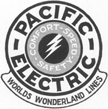Return to ERHA homepage
W Pacific Electric
Riverside Corona Line
Pacific Electric
Riverside Corona Line
Introduction:
W
RIVERSIDE-CORONA LINE
This line served both as an interurban service for travel between Riverside and Arlington and Corona, and also to a not inconsiderable degree as a local line serving the residential district of Riverside south of the business district. Between Riverside and Arlington, tracks were located in the center of Magnolia Avenue, a portion of the distance being paved and the rest open track. From Arlington to Corona, the major portion of the line was on private way except for a small portion on paved streets within the
two cities. The entire line was single track except on Main St., Riverside, where it was double-tracked between 1st and 14th Streets. 14.53 miles.
ROUTE: from Riverside(6th & Main Streets.) south on Main to 14th, then continued south on Magnolia Ave. and private way through Arlington to Corona were it ran south on 3rd St. to Merrill.
HISTORY: Built to Arlington 1893 by R&A as horse car line. Rebuilt and electrified by R&A in 1899, with first electric car for Arlington leaving Riverside at 9:00 AM 11 April 1899. Rerouted from Brockton Ave. to New Magnolia Ave. on 20 October 1914. Extension to Corona placed in service on 17 February 1915. On 7 July 1924, separated: Riverside to Arlington and
Arlington to Corona. On 1 April 1928 through routed with Riverside-San Bernardino Line; 15 June 1928 again became Riverside-Arlington Line. Arlington-Corona service was abandoned on 11 August 1931. Rerouted from Main St. to Market St. on 1 November 1931. Riverside-Arlington service abandoned on 10 January 1943. Freight service continues, although dieselized in 1943.
OPERATION: As of 1927 a 30 minute service between Riverside and Arlington was provided from 6:00 AM to 11:30 PM; between Arlington and Corona, a two hour headway was maintained throughout the day with extra trips morning and evening. Distances and running times: Riverside-Arlington, 6.62 miles and 22 minutes; Arlington-Corona, 7.2 miles and 16 minutes. Six crews were needed; two crews (one man each) with headquarters at Arlington were assigned to the Arlington-Corona run. 70 trips daily were made between Riverside and Arlington, and 20 daily between Arlington and Corona.
678,277 passengers rode the line in 1914; 457,762 in 1926. Passengers revenue for 1926 was $40,300; estimated cost of operation was $47,600 plus $2,800 in taxes---leaving an estimated loss of $10,000.
EQUIPMENT: Riverside-Arlington had moderately large cars throughout its life. From 1914 to 1931, cars of the 480 Class were used; 600s replaced them from 1933 to 1940; 100s thereafter. Arlington-Corona had 480s until
7 July 1924, then a Birney.
MISCELLANY: Power (600 v.) provided by Substation No. 27 at Riverside and Substation No. 48 at Corona.
SP track on Market St. from 1st to 14th was electrified in 1915, and the SP depot at 7th & Market was turned over to PE. SP steam engine maintenance facilities and yard at 5th and Market were also given over to PE. SP abandoned passenger service between Riverside and Colton on 4 Jan 1914, turning over this business to PE.
The old Huntington dream to connect his Whittier line to the R&A system by building through the Santa Ana Canyon from Stern to Arlington(about 17 miles) was fated never to be accomplished. Even after the 1911 Merger,
SP-PE officials made numerous field trips to the Canyon; two alternative routes were surveyed, one on either side of the river, with the route on the west side favored(this would have crossed the Santa Fe Railway at Prado). This 1911 plan would have given the Stern-Arlington construction precedence over Upland-San Bernardino---giving eventually a belt line to and from L.A. via all important cities in the Orange Empire. This was Huntington's 1903 plan except for the elimination of his branches to San Diego and Santa Ana.
Deterioration of the double-track on Main St. between 1st and 14th Streets. caused Riverside-Arlington service to be rerouted via Market St. in 1936; Main St. rails were removed that year.
Principal points of interest passed on this line were: Riverside High School(14th & Magnolia), Woodcraft Home(Adams & Magnolia), Sherman Indian School(Magnolia & Jackson), County Hospital in Arlington, and the La Sierra Canning Company at Tyler.
There were three crossings of steam railroads at grade: MP 2.24(UP), MP 10.10(AT&SF) and MP 12.59(AT&SF). The UP crossing was protected by the Magnolia Interlocking Plant(time release); May Tower governed the Corona crossing of the AT&SF main line; AT&SF Elsinore branch was flagged.
PE timetables listed as "outbound" trains from Corona to Riverside; "inbound" from Riverside to Corona. All trains were first class, and inbound trains were superior by direction to outbound trains of the same class.
The large trees growing along Magnolia Ave. gave the line certain distinction and beauty, but were dangerous to train crews; rules prohibited trainmen riding on car roofs between Magnolia Station and Tyler.
In May, 1924 the 480s made the Arlington-Corona run in 16 minutes; two months later a Birney replaced them and running time became 23 minutes.
Only two years before it abandoned passenger service in Corona, PE spent $17,000 rebuilding track in that town. In 1929, track was reconstructed on Third St. between Grand and Merrill.
After removal of the Riverside Station in 1940, Riverside-Arlington cars terminated at 1st and Market.
Return to ERHA homepage
